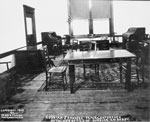 CONFERENCE HOSTS
CONFERENCE HOSTS

On the morning of August 8, Rear Admiral William Mead left the Portsmouth Shipyard on his barge to greet the Russians, and then the Japanese whose ships were waiting beside Whale Back Light.
For Mead and local people on both sides of the Piscataqua River, this day had been anticipated for nearly a month. On July 10, the Portsmouth Herald announced that the city would host the conference and planning was underway to use the shipyard and the Wentworth. A few days later, August 7 was announced as the starting date, a day changed when bad weather delayed arrival of the ships off Portsmouth.
Decorations covered the downtown buildings and although the Stars and Stripes was hanging everywhere, people were asked not to display the flags of Japan and Russia lest some slight be taken by either delegation.
The most decorated buildings were the offices of Western Union and the Postal Telegraph Company and city hall. The county courthouse was festooned with bunting and flags and featured life-size portraits of Washington and Grant.

Portsmouth's Congress Street with holiday decorations. Portsmouth Athenaeum collection. View larger image.

Whale Back Lighthouse, at the mouth of the Piscataqua River. Richard Candee collection.
Governor John McLane and other state officials moved to the Wentworth for the month of August and Niles cottage was donated to Assistant Secretary of State Herbert H.D. Peirce, who was President Roosevelt's personal representative at the conference, could use it.
Despite all of the arrangements that were being made for the meeting, Rear Admiral Mead was not officially informed by Washington of the order to set up for the conference until Wednesday, August 2. At 9 a.m. on Thursday, 200 men began working around the clock to convert the second floor of the new naval stores building for use as the conference headquarters.
In the building's one large room, partitions were erected creating space for the conference meeting room, three-room suites on each side for each delegation, a reception room for the United States representatives, and two fireproof rooms for document storage.
Three carloads of furniture for the conference arrived from Philadelphia and three janitors, appointed directly by the state department, were hired to maintain the naval stores building. Forty-foot cutters, built at the yard for use on battleships but not yet in commission, were fitted out for use by the delegates to provide alternative transportation between New Castle and the yard. A twenty-five-man detachment of sailors from the Wabash, then in Boston, was sent to Portsmouth to crew the cutters during the conference.
The peace negotiations were to drag on for nearly a month, but for the people of the Maine and New Hampshire seacoast, even the treaty signing was anticlimactic compared to the excitement of the day when the delegations were received in Portsmouth. The arrival of hundreds of visitors including many famous journalists from this country, Europe, and Japan foretold the importance of the event. Booked several days in advance, the Wentworth, the Rockingham, the Kearsarge, and the Merrick hotels were full, the latter three primarily with newsmen.
On August 8, after visiting both delegations, Admiral Mead returned to the shipyard to await the arrival of the Russians and the Japanese. At 11:15 a.m., Secretary Peirce and his party left the Galveston for the Navy Yard, their journey from the ship shadowed by darting tugs with photographers aboard.

Secretary and Mrs. Peirce hosted many receptions and dinners at the Niles Cottage in New Castle. Portsmouth Athenaeum collection. View larger image.

Rear Admiral William Mead, commander of the Portsmouth Naval Shipyard, in civilian clothes, outside the General Stores building where the treaty negotiations were held. Portsmouth Athenaeum collection. View larger image.

The main conference room of the second floor of the General Stores Building. Portsmouth Athenaeum collection. View larger image.

The Russian attache's office in the General Stores Building. Portsmouth Athenaeum collection. View larger image.
